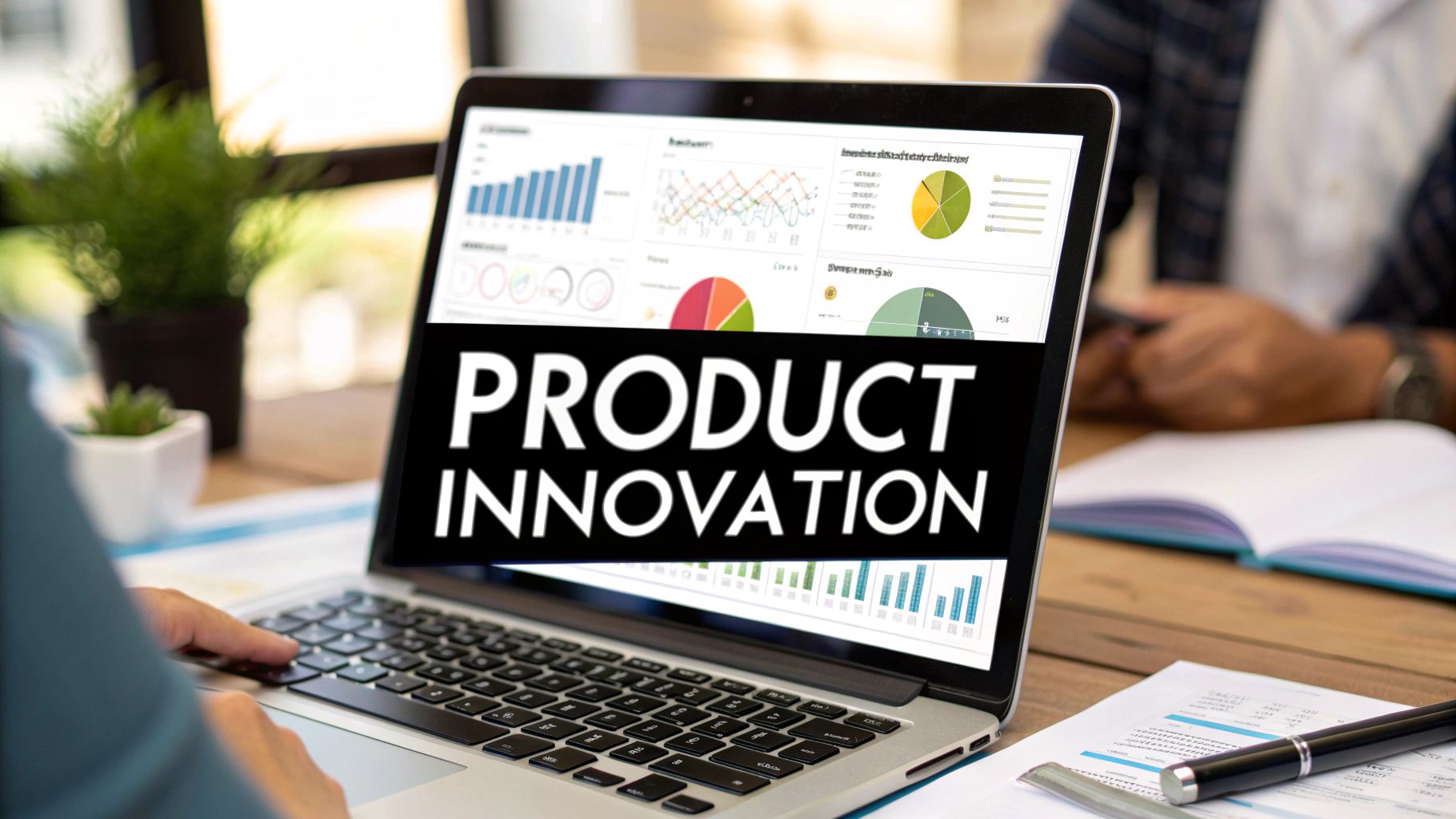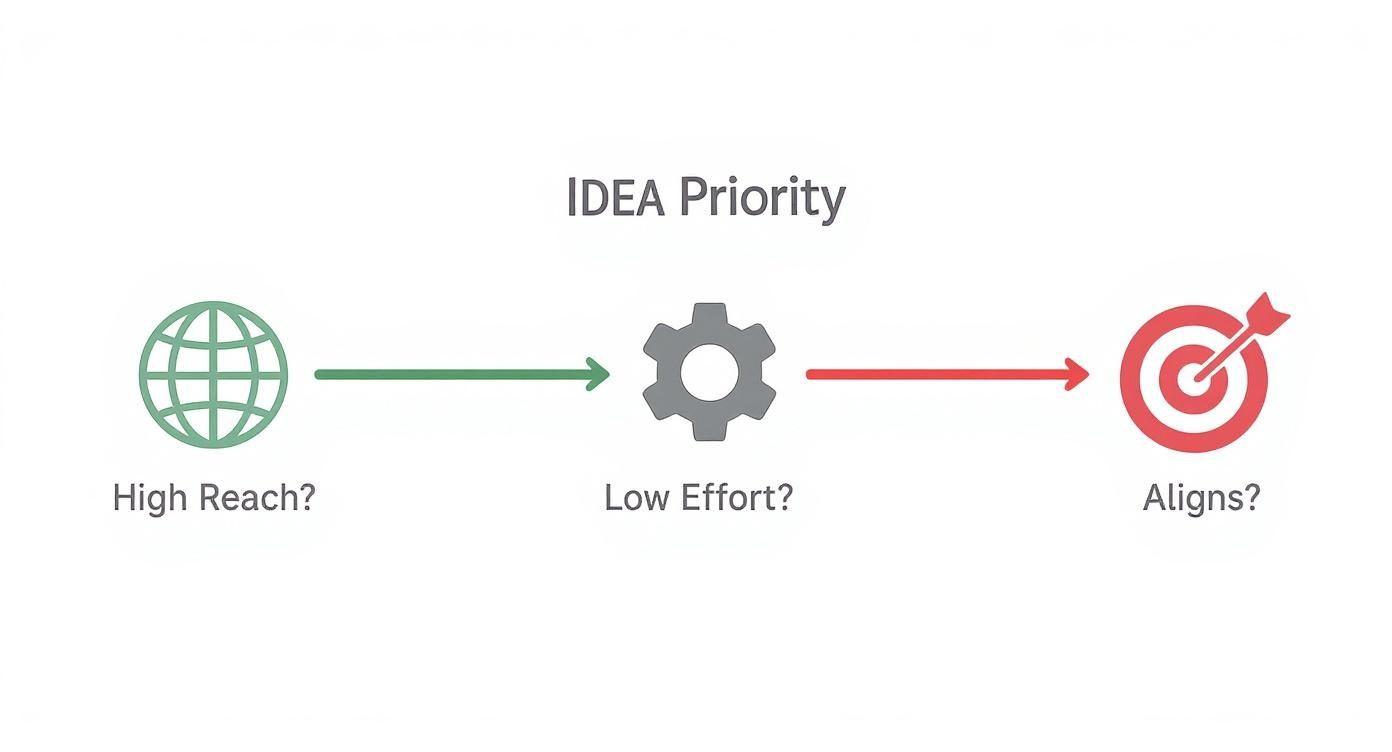Stay Updated with Everything about MDS
Thank you! Your submission has been received!
Oops! Something went wrong while submitting the form.

Chilat Doina
November 17, 2025
So, what exactly is a product innovation strategy?
Think of it as the playbook your e-commerce brand uses to dream up new products or seriously level up the ones you already sell. It’s all about having a repeatable system for finding market insights and actually doing something with them to stay ahead of the curve and keep customers happy.

Before you start chasing that next "game-changing" product, you need to get your house in order. Real innovation isn’t a lightning strike of genius; it’s the result of a deliberate, repeatable process that’s baked into your company culture.
For e-commerce brands, this means moving past the occasional brainstorming session. You need to build a machine for continuous improvement and discovery.
This foundation starts with a deep, ongoing analysis of what's happening in your market. It’s not just about watching what your competitors are doing, but understanding why they're doing it. More importantly, it’s about decoding the subtle shifts in customer behavior that point to new opportunities—the genuine gaps that your brand is perfectly positioned to fill.
Some of the best ideas for your next product won't come from a fancy offsite meeting. They're hiding in plain sight, scattered across every part of your business. The trick is building a system to catch them.
Your internal teams are your direct line to what customers really need. Start looking in these places:
The goal here is to formalize this process. Don't let a golden nugget of an idea die in a forgotten Slack channel. Set up a central spot—a simple spreadsheet or a tool like Airtable—where anyone, from any department, can drop an idea for regular review.
Every new idea, no matter how exciting, needs to pass a simple test: does it actually help the business? An innovation strategy without clear goals is just an expensive hobby.
Before you sink a single dollar into a new concept, ask the tough questions. Does this idea strengthen our brand? Does it speak to our ideal customer? Will it boost customer lifetime value or stop people from churning?
This acts as a filter, keeping you from chasing shiny objects or fleeting trends that don’t serve your long-term vision. It ensures your innovation efforts are truly strategic.
Finally, you have to put your money where your mouth is. A sustainable innovation strategy needs a dedicated Research & Development (R&D) budget. It’s a direct signal of how committed you are to growth.
Be ambitious but realistic. Look at industry benchmarks to see what others are spending. R&D intensity—spending as a percentage of sales—can vary wildly. For instance, the pharma and software industries are pouring 19% and 14% of their sales back into R&D, respectively. Meanwhile, consumer goods and automotive brands often work with tighter budgets.
Understanding where your niche sits helps you set a competitive budget. You can dig deeper into global innovation trends to see how spending is evolving. This data-driven approach makes sure your innovation engine is properly funded and ready for success.
That sudden rush of new product ideas? It's a great problem for any brand to have. But it also presents a very real challenge: How do you separate the genuine market-winners from the expensive duds before you start sinking real money into them?
The answer isn't just "go with your gut." To build a healthy, predictable innovation pipeline, you have to move from subjective feelings to a data-driven system. This means creating a prioritization framework that fits your e-commerce business.
Without one, it's all too easy to spread your team too thin, chase trends that fizzle out, or pour capital into projects that just don't line up with your long-term vision. The right framework brings much-needed clarity and objectivity to the chaos.
The push for innovation is accelerating, too. A 2025 Deloitte outlook found that 95% of consumer products executives are making new product launches a top priority, and 80% plan to boost their investment in this area. This just hammers home how critical a solid prioritization process is for staying competitive.
Let's get practical. Two of the most effective models I've seen e-commerce brands use are the RICE framework and the Value vs. Effort matrix. They offer different ways to look at your ideas, helping you make smarter, more strategic bets.
You don't have to pick just one, either. Many brands use the Value vs. Effort matrix for a quick first-pass sort and then apply the more detailed RICE score to the most promising contenders.
Here's a quick look at how they stack up.
Ultimately, both frameworks push you toward the same goal: making conscious trade-offs based on data, not just excitement.
Let's see how an online apparel brand might put these into practice.
A Value vs. Effort matrix is perfect for that initial, high-level sorting. It’s a simple 2x2 grid where you plot each concept based on its potential business value (high/low) and the effort required to make it happen (high/low).
The RICE framework takes it a step further by forcing you to get quantitative. You score each idea on four factors: Reach, Impact, Confidence, and Effort. This turns a vague concept into a hard number, making it much easier to compare apples to oranges.
RICE in Action: An Apparel Brand Example
- Idea: Launch a new line of sustainable, performance-based activewear.
- Reach: Estimate 5,000 customers/month.
- Impact: High (3x score), since it aligns with brand values and has high-margin potential.
- Confidence: 75%, based on positive survey data but it's still untested in the real world.
- Effort: 6 person-months for design, sourcing, and launch.
The resulting RICE score gives you a concrete number to weigh this big project against smaller ideas, like a seasonal accessory drop.
A good framework does more than just help you rank a list. It forces you and your team to get real about your assumptions.
For an e-commerce gadget company, this means getting specific. Instead of saying an idea has "big potential," you have to actually estimate the market reach. How many units could you realistically move in the first quarter?
"Effort" can't be a fuzzy concept, either. You need to break it down into tangible costs:
This is where the magic happens. By assigning concrete numbers, you strip away the emotion and guesswork. You start building a predictable innovation engine. For more on this critical first step, check out our guide on how to find winning products—it's a perfect deep dive into the discovery process that feeds this whole system.
An idea is just a guess until you get it in front of real customers. Once you've got your list of promising concepts, the next move is to de-risk them. This is all about testing your core assumptions as quickly and cheaply as possible, getting honest feedback before you even think about a full production run.
For e-commerce brands, rapid prototyping is your best friend here. We're not talking about building a perfect, final product. The goal is to create a simple, tangible version of your idea—just enough to get a real reaction from your target audience. That feedback loop is what turns a decent idea into a killer product.
Think about it: the cost of being wrong gets exponentially higher the further you go. A small tweak based on early feedback might cost a few hours of design time. The same change after you've ordered a massive container of inventory? That could easily be a six-figure mistake.
You don't need a huge R&D budget to start testing your ideas. The trick is to pick a prototyping method that delivers the most learning for the least amount of cash. Remember, the goal is validation, not perfection.
Here are a few practical methods that work incredibly well for online brands:
The core principle is simple: test the riskiest assumption first. If you're not sure people will like the scent of a new candle, don't spend months perfecting the packaging. Get scent samples out to a test group and see what they think.
Prototyping isn't just about the product; it's also about validating market demand. You have to answer the most important question: "Will people actually pay for this?" This is where so many brands stumble.
Here’s a quick decision tree that shows how to filter ideas based on their strategic fit, which is a huge part of the validation process.

This kind of visual guide helps you quickly gut-check whether an idea has the potential reach and low-enough effort to pursue, all while making sure it actually fits your brand's mission.
You can then pair your digital prototypes with some smart marketing tests to see if people are willing to pull out their wallets.
These simple tests can give you powerful data on whether your product idea really has legs.
By combining low-cost prototypes with these validation tactics, you create a powerful de-risking engine. This process ensures that by the time you're ready to invest serious capital, you're not just running on a hunch—you're moving forward with a product concept that has already shown real signs of market demand.
https://www.youtube.com/embed/TZe5UqlUg0c
Artificial intelligence isn't just some far-off concept for tech giants anymore. For savvy e-commerce brands, it's a real, practical tool that’s sharpening their competitive edge right now. By weaving AI into your development cycle, you can shrink the time from a spark of an idea to a full-blown launch, turning what used to be months of grunt work into just days of automated analysis.
This shift is huge. It moves your brand from just reacting to trends to actually getting ahead of them. Instead of guessing what customers might want next, you can use hard data to build your entire product innovation strategy from the ground up.
Some of the best product ideas are buried in places you'd never have time to look—the thousands of customer reviews, messy support tickets, and random social media comments your brand gets every day. Trying to sift through all that feedback manually is a nightmare. AI-powered tools can do it in minutes.
Machine learning algorithms can scan all that text for patterns, sentiment shifts, and pain points customers don't even know they're articulating. Imagine discovering that 20% of your negative reviews all point to the same tiny design flaw you never noticed. That’s a direct, data-backed signal telling you exactly what to fix or improve in your next product.
This AI-driven approach is reshaping how products get made on a global scale. The 2025 AI Index report found that nearly 90% of notable AI models now come from private industry, showing just how deeply companies are embedding AI into their core operations. The report also highlights a massive 21.3% rise in legislative mentions of AI across 75 countries from 2023 to 2024, signaling intense government focus on its potential.
AI’s role doesn't stop at data analysis; it can be a surprisingly good creative partner, too. When your team hits a wall, generative AI tools can help brainstorm new product features, spitball marketing copy, and even dream up visual designs.
If you really want to speed things up, especially in the design phase, you should see how you can leverage artificial intelligence for design to generate fresh concepts. For instance, a home goods brand could ask an AI to create hundreds of unique pattern variations for a new pillow line in a single afternoon.
AI isn’t here to replace human creativity. It’s here to supercharge it. Think of it as a tireless assistant that handles the heavy data lifting and initial brainstorming, freeing up your team to focus on the big-picture strategy and execution.
This process lets you test way more ideas, way faster. Instead of getting bogged down for weeks on a single concept, you can generate and vet a dozen, seriously upping your odds of finding a true winner.
Once you've landed on a promising idea, AI can help streamline its journey to market. This is where accessible, practical applications make a huge difference for e-commerce brands of any size. For a deep dive into tools you can start using today, check out our guide on AI tools for e-commerce.
Here are a few specific ways AI can smooth out your pipeline:
By embedding these AI-powered tactics into your workflow, you’re building a smarter, faster, and more responsive innovation engine. You're no longer just making products; you're building a system for continuous, data-driven improvement that will always keep you one step ahead.

After all the research, prototyping, and tweaking, you finally have a product you know is a winner. But here’s the hard truth: even the most amazing innovation can fail if it’s launched into a vacuum. A powerful go-to-market (GTM) strategy is what separates a product that exists from a product that sells, building that critical momentum from day one.
This isn’t about just flipping a switch and sending a "we're live!" email. A real GTM strategy is a coordinated playbook that gets your marketing, sales, and operations teams all rowing in the same direction. It’s how you make sure your product lands in front of the right people, with the right message, at the perfect time.
Without a solid plan, you're just asking for a messy launch that confuses customers, drains your marketing budget, and misses out on those crucial early sales you need to get off the ground.
Before you can shout about your new product from the rooftops, you have to know exactly who you're talking to. Your launch audience isn't just everyone. It’s a very specific slice of your broader market—those early adopters and ideal customers who are most likely to get excited about what you’ve built.
Get specific here. Don't just settle for basic demographics. You need to understand their biggest frustrations, where they hang out online, and what actually influences them to pull out their wallets.
Once you’ve got a crystal-clear picture of your audience, you can nail your unique value proposition (UVP). This is a simple, punchy statement that answers one critical question: "Why should I buy this from you?" Your UVP has to scream what makes your product different and better than everything else out there. This is the heart of every single piece of launch content you'll create.
A modern launch isn't a single event; it's a story that unfolds across multiple channels, creating a wave of excitement. The goal is to build genuine hype and make your audience feel like they're in on something special.
Think of your campaign as a phased rollout, not a one-day event.
A killer launch feels like a story unfolding. Each piece of content, from the first teaser to the final "buy now" email, builds on the last. You're creating an irresistible narrative that leads directly to a purchase.
To keep all these moving parts aligned, a launch checklist is your best friend. It ensures no stone is unturned and that every team knows exactly what they're responsible for, and when.
Here’s a simple checklist to get you started, covering the core functions of your e-commerce business.
This checklist is a starting point—customize it to fit your specific product and business needs to ensure a seamless execution from start to finish.
How you price your new product sends a loud and clear message about its quality and value. This decision can't be based on a gut feeling or simply covering costs. It’s a strategic choice that has to be informed by your brand positioning and what the competition is up to.
Are you positioning this as a premium, top-of-the-line solution? Your price needs to reflect that. Or are you aiming to be the most accessible, value-driven option? That requires a different pricing strategy entirely.
Take a hard look at what your direct and indirect competitors are charging. This analysis will help you find that sweet spot where your price feels competitive but still protects your profit margins. For a deeper dive into the whole process, from idea to execution, check out our complete guide on how to launch a new product.
Your marketing can be flawless, but if your operations aren't ready to handle the demand, the entire launch can come crashing down. A smooth, frustration-free customer experience is non-negotiable from the very first order.
Before you go live, do one final pass on this operational checklist:
Launching your new product isn’t the finish line; it's the starting gun. I’ve seen countless brands make this mistake. The most powerful product innovation strategies treat a launch as the beginning of a conversation with the market, not the end of one.
True, sustainable growth comes from obsessively listening to what the data tells you. Once your product is live, you've moved from assumptions and projections to real-world performance. This is where you use those insights to iterate, refine, and fuel your next big idea. By tracking the right numbers, you make intelligent, data-backed decisions instead of just relying on gut feelings. It creates a powerful flywheel where every launch—successful or not—provides the raw material for your next innovation.
You can't improve what you don't measure. The first thing you need to do is build a simple, clear dashboard of key performance indicators (KPIs) that gives you a real-time pulse on your new product's health. You have to avoid vanity metrics like raw traffic numbers and focus on the data that actually impacts your bottom line.
For any e-commerce brand, this means zeroing in on a few critical numbers:
These metrics give you a clear, unbiased picture of how your product is truly performing out in the wild.
Gathering data is the easy part. The real skill is knowing what to do with it. Your post-launch metrics are signals that should guide your next moves, turning your product strategy into a living, breathing process.
You have to look at the relationships between your KPIs. For instance, a low CAC is great, but if it's paired with an equally low LTV, you might just be acquiring one-time bargain hunters, not building a loyal customer base. That insight tells you to immediately shift focus to retention strategies for these new buyers.
The goal isn't just to track numbers but to understand the story they're telling. If your return rate spikes, don't just process the refunds. You need to dig into the "why"—read the return comments, survey those customers, and find the root cause. That feedback is pure innovation gold.
The data should prompt specific, strategic questions that guide your actions.
To truly understand the impact of your launch, implementing effective strategies for measuring social media success is also crucial. Social sentiment and engagement metrics can provide early qualitative data that adds a ton of color to your quantitative KPIs.
By creating this tight feedback loop, you ensure your product innovation is constantly evolving based on real customer behavior, not just your internal assumptions. Each product launch becomes a learning opportunity, making your next bet smarter and far more likely to succeed.
At Million Dollar Sellers, we know that building a data-driven growth flywheel is what separates the top 1% of e-commerce entrepreneurs. Our exclusive community is built on sharing the exact strategies and metrics that 7-, 8-, and 9-figure founders use to scale their brands. If you’re a serious seller ready to move beyond guesswork and start making smarter, more profitable decisions, learn more and see if you qualify to join MDS. https://milliondollarsellers.com
Join the Ecom Entrepreneur Community for Vetted 7-9 Figure Ecommerce Founders
Learn MoreYou may also like:
Learn more about our special events!
Check Events